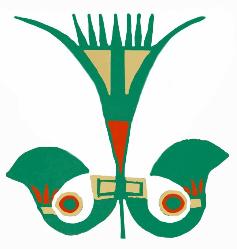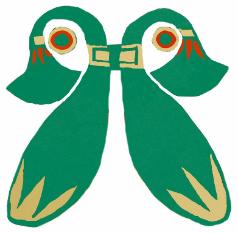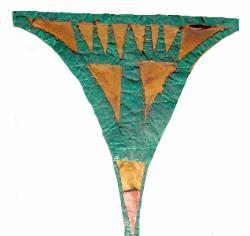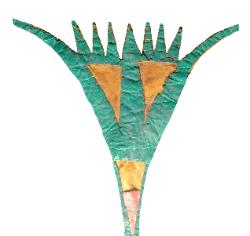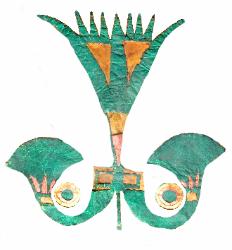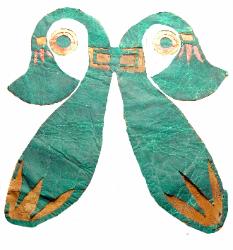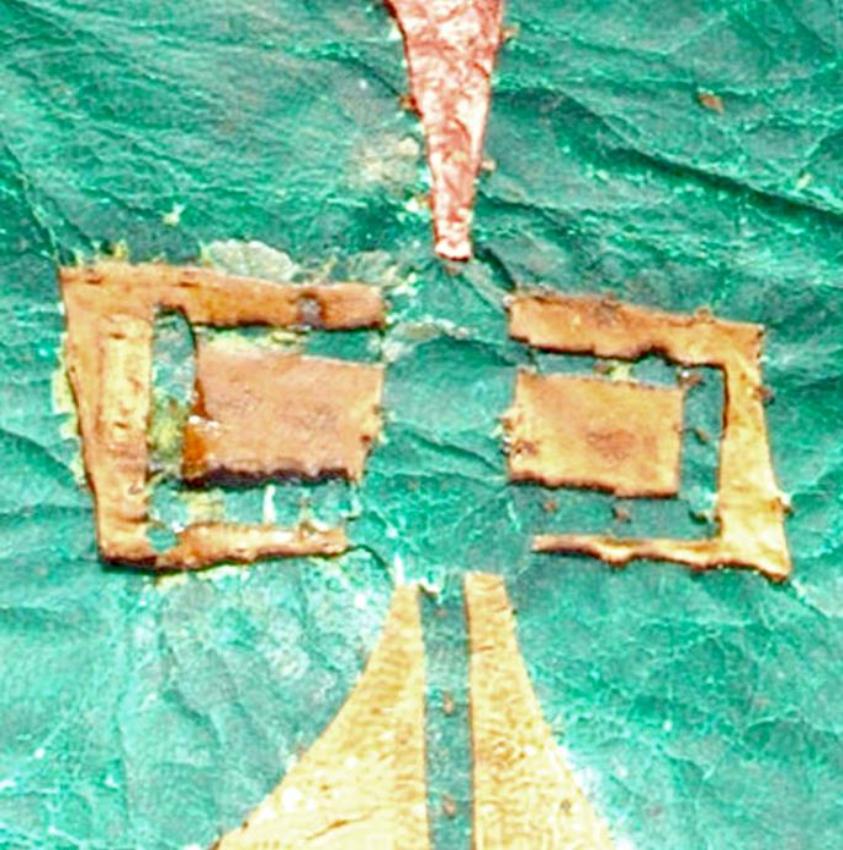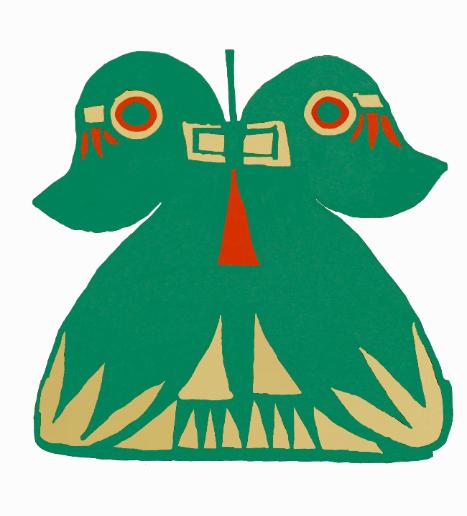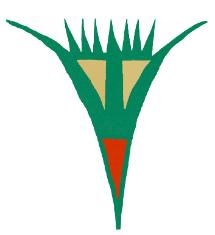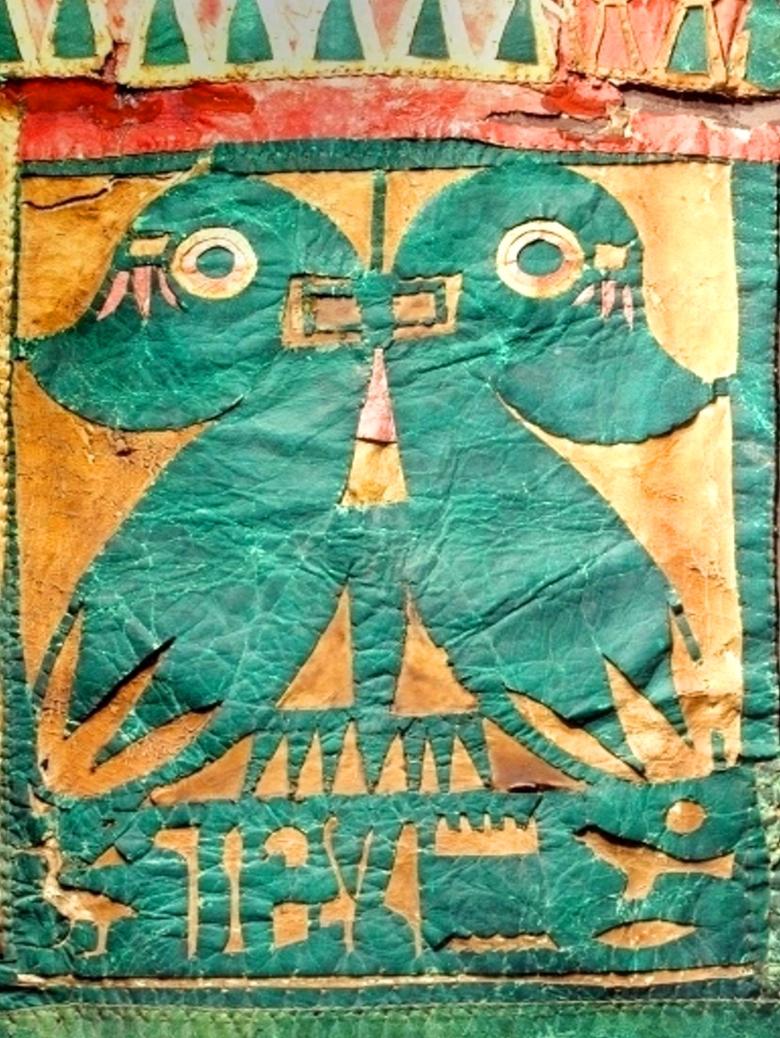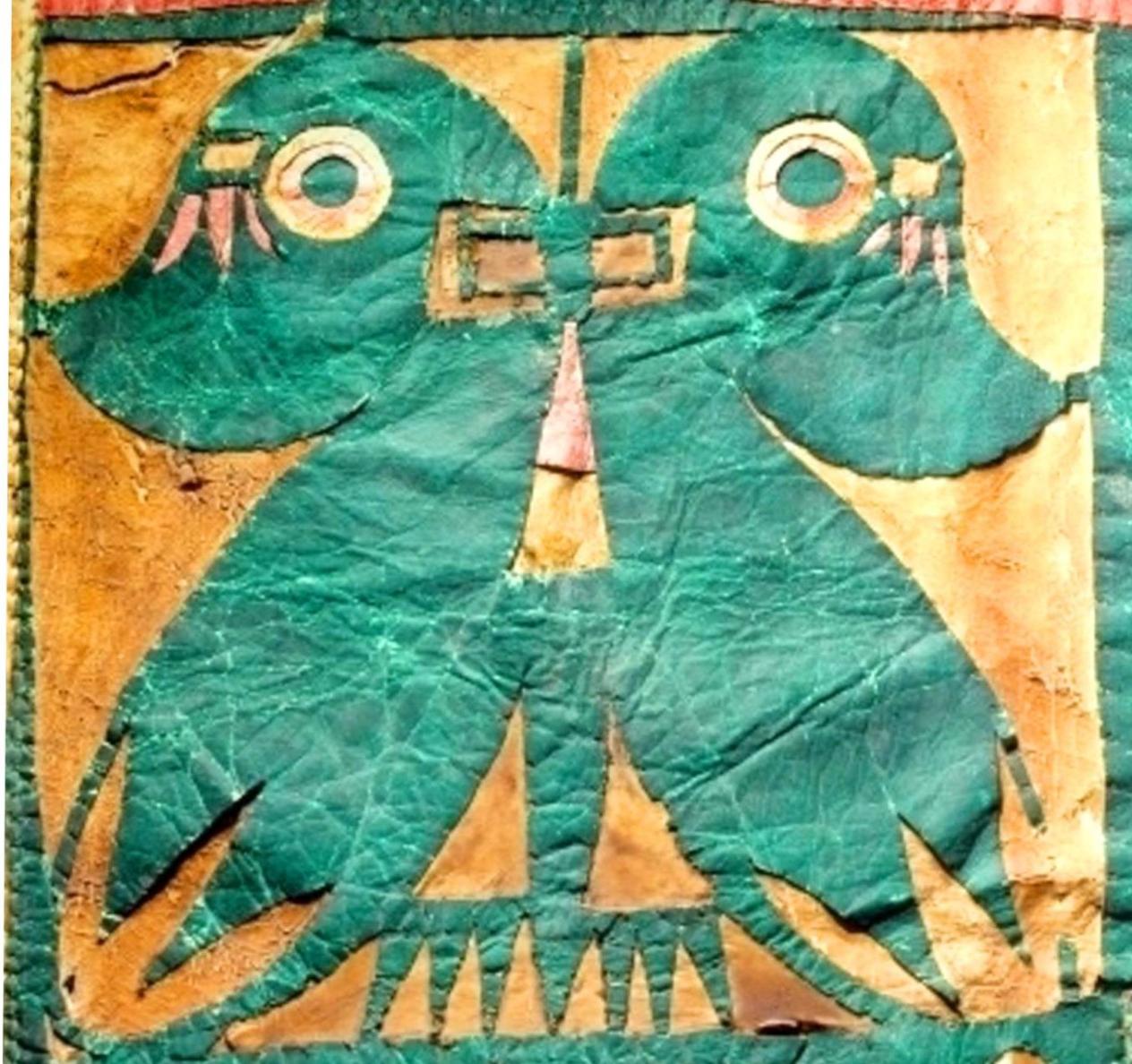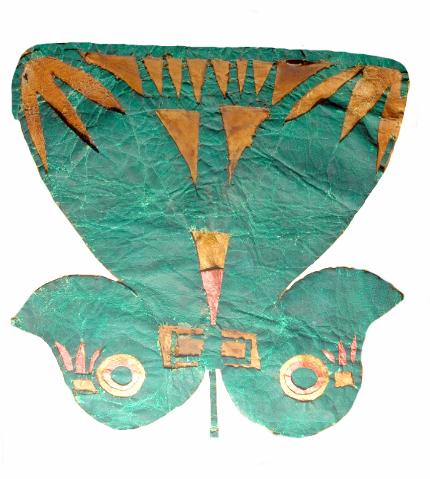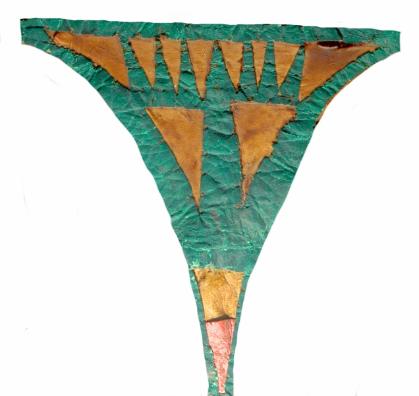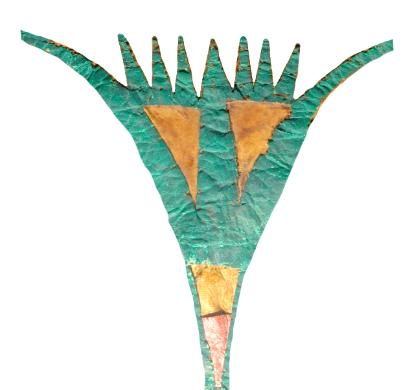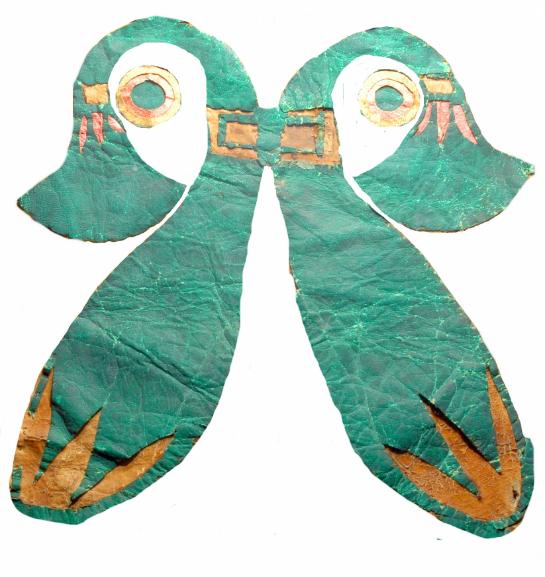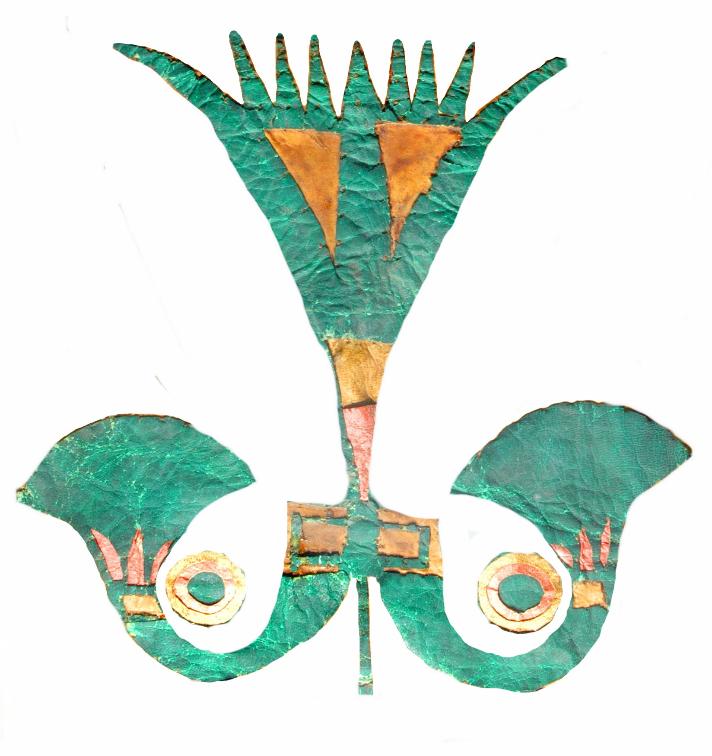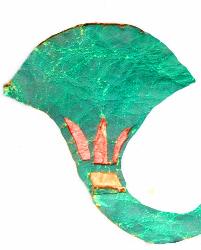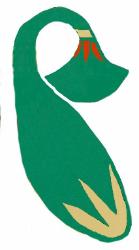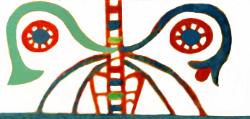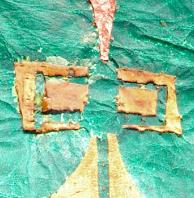| Russian Academy of Sciences Centre for Egyptological Studies, Moscow (CESRAS) & Russian Institute of Egyptology in Cairo (RIEC) A Puzzle solved: a Unique Unification Symbol on the Funerary Baldachin of Asetemachbjt B Baldachin Directory |
What is it? .....for 130 years egyptologists who know the baldachin have puzzled over this little figure.
Some have suggested that it is some kind of mythical animal, others have suggested some sort of
vegetable. After quite a lot of thought, it became clear to me what it really is and what it means. Here you
will see the solution to the puzzle. Edward Loring/CESRAS/2009
Scroll right and down
Some have suggested that it is some kind of mythical animal, others have suggested some sort of
vegetable. After quite a lot of thought, it became clear to me what it really is and what it means. Here you
will see the solution to the puzzle. Edward Loring/CESRAS/2009
Scroll right and down
| What is it? |
Above we see a strange design which is only known to exist on this object
in the row of decorative images on the upper surfaces of the baldachin's
sides. Below it is a cut-out inscription, Isetemkheb's filiation (sAt Hm-nTr tpy n
jmnw raw) and the beginning of her title (wr...) which is continued in the
following vignette. Notice the stiching.
in the row of decorative images on the upper surfaces of the baldachin's
sides. Below it is a cut-out inscription, Isetemkheb's filiation (sAt Hm-nTr tpy n
jmnw raw) and the beginning of her title (wr...) which is continued in the
following vignette. Notice the stiching.
We cut off the inscription which has nothing to do with the figure and enlarged it
slightly to make every detail clear. We see something like a weird creature with two
heads at the top and some fringes at the bottom of what could be as body.
Now let us look at it differently, turned upside down.
Scroll down
slightly to make every detail clear. We see something like a weird creature with two
heads at the top and some fringes at the bottom of what could be as body.
Now let us look at it differently, turned upside down.
Scroll down
Here we can begin to see
that we have a
composition of elements
merged together.
Starting with the fringe
shown here at the top,
we follow the curves of
its outermost elements
downwards . They must
have a meeting place on
the central axis of the
figure. The Ancient
Egyptians were very
partial to axial symmetry.
that we have a
composition of elements
merged together.
Starting with the fringe
shown here at the top,
we follow the curves of
its outermost elements
downwards . They must
have a meeting place on
the central axis of the
figure. The Ancient
Egyptians were very
partial to axial symmetry.
Following the course stated above, we have found a lotus blossom, standing for Upper Egypt.
This being the case, the papyrus of Lower Egypt can not be far away. Removing the lotus which
we have just cut out and returning the figure to its original upright position we find the
composition below.
This being the case, the papyrus of Lower Egypt can not be far away. Removing the lotus which
we have just cut out and returning the figure to its original upright position we find the
composition below.
Here we have two papyrus plants joined by a type of clasp
across the central axis through which our lotus passed.
Removing the lower portions of the papyrus plants while
restoring the lotus to its proper place gives us a symmetrical
composition of the blossoming elements of both plants: Upper
and Lower Egypt bound by a clasp of unity.
across the central axis through which our lotus passed.
Removing the lower portions of the papyrus plants while
restoring the lotus to its proper place gives us a symmetrical
composition of the blossoming elements of both plants: Upper
and Lower Egypt bound by a clasp of unity.
| Scroll Right |
Artist's graphic renditions of depicted
elements. As all original colours of the
leather pigmentation have mutated during
the past 3000 years and the baldachin
appears to have been seriously mistreated
both in antiquity and by E. Brugsch in 1881,
the colours shown here, interpolated from
test macro photos taken through dirty glass
with minimal ambient light, are for basic
orientation only.
elements. As all original colours of the
leather pigmentation have mutated during
the past 3000 years and the baldachin
appears to have been seriously mistreated
both in antiquity and by E. Brugsch in 1881,
the colours shown here, interpolated from
test macro photos taken through dirty glass
with minimal ambient light, are for basic
orientation only.
Here we offer a small group of unification symbols
and the scenes where they occur. Click on small
"thumbnails" for full-size original CESRAS images.
and the scenes where they occur. Click on small
"thumbnails" for full-size original CESRAS images.
Everything posted on this page is original, otherwise unpublished research material, the work of CESRAS scholars. It is the intellectual property of the
Russian Academy of Sciences, Moscow, R.F., Centre for Egyptological Studies. As educators, we believe it is our pleasure and duty to share our material with
all interested persons worldwide. Knowledge which is not shared is worthless. You are free to use any original CESRAS-RIEC material for non commercial
purposes. If you publish any of our images, please be so kind as to give a credit to The Russian Academy of Sciences, CESRAS.
We hope that you enjoy visits to cesras.org and that you will find material and inspiration for your own studies. We will continually be publishing more and
more of our thousands of original photographs, as well as full versions of books, articles and photos from the early days of Egyptology which are only
available to the very limited group of professional Egyptologists. We would consider it kind, if you make a link from your website to ours:
http://www.cesras.org/. Should you have questions pertaining to this site, or CESRAS in general, you can contact us at admin@cesras.org and receive an
answer as time allows. Thanking your interest and wishing you all good, Edward R. Loring, Research Fellow, CESRAS, Site Administrator
Russian Academy of Sciences, Moscow, R.F., Centre for Egyptological Studies. As educators, we believe it is our pleasure and duty to share our material with
all interested persons worldwide. Knowledge which is not shared is worthless. You are free to use any original CESRAS-RIEC material for non commercial
purposes. If you publish any of our images, please be so kind as to give a credit to The Russian Academy of Sciences, CESRAS.
We hope that you enjoy visits to cesras.org and that you will find material and inspiration for your own studies. We will continually be publishing more and
more of our thousands of original photographs, as well as full versions of books, articles and photos from the early days of Egyptology which are only
available to the very limited group of professional Egyptologists. We would consider it kind, if you make a link from your website to ours:
http://www.cesras.org/. Should you have questions pertaining to this site, or CESRAS in general, you can contact us at admin@cesras.org and receive an
answer as time allows. Thanking your interest and wishing you all good, Edward R. Loring, Research Fellow, CESRAS, Site Administrator
